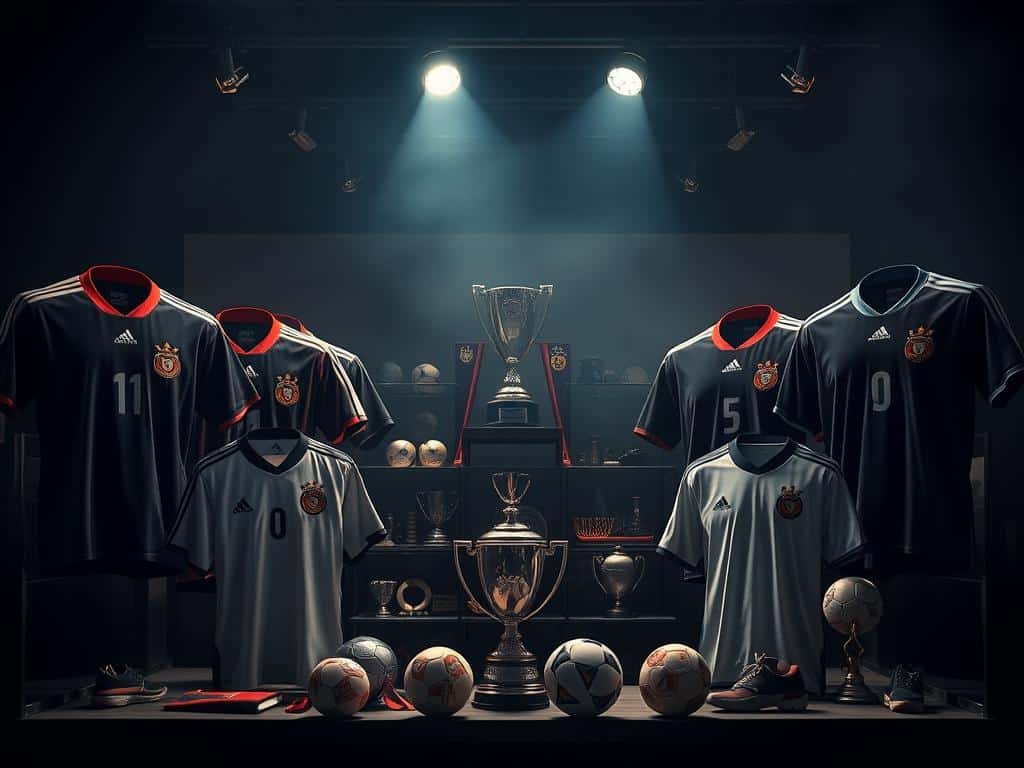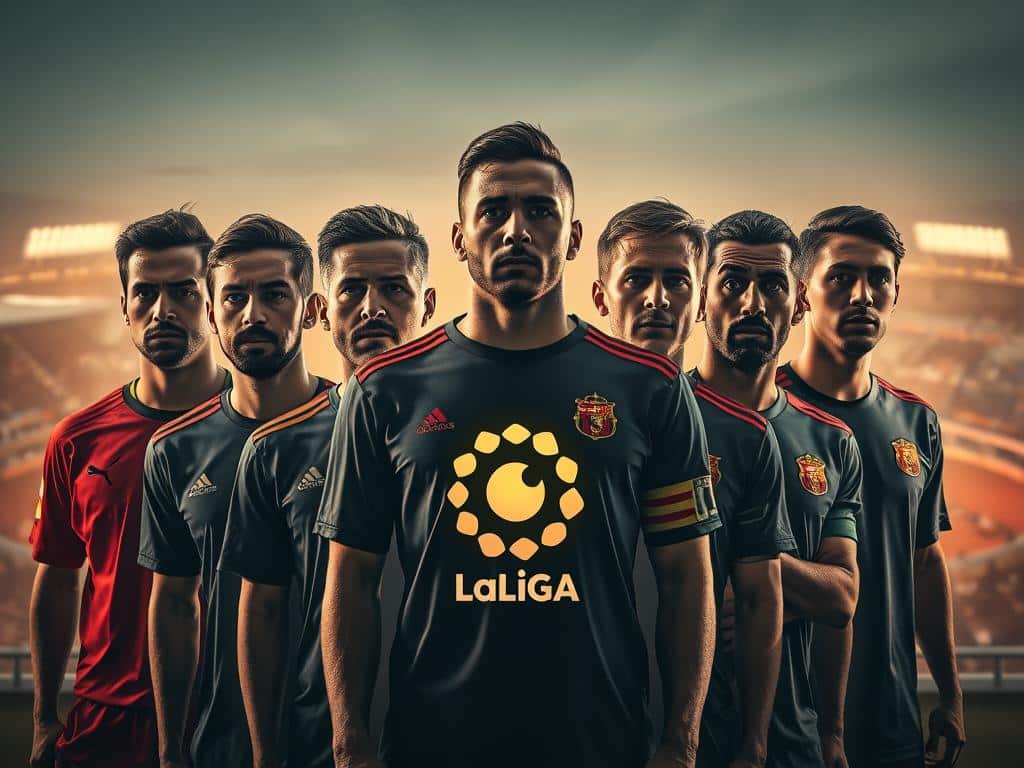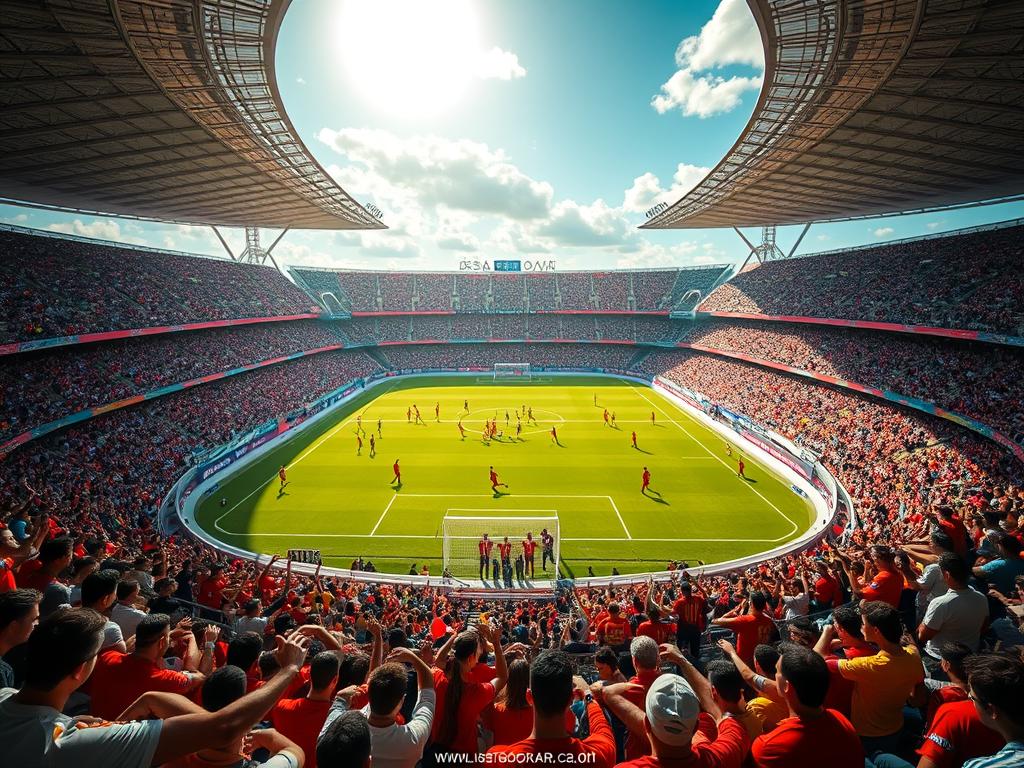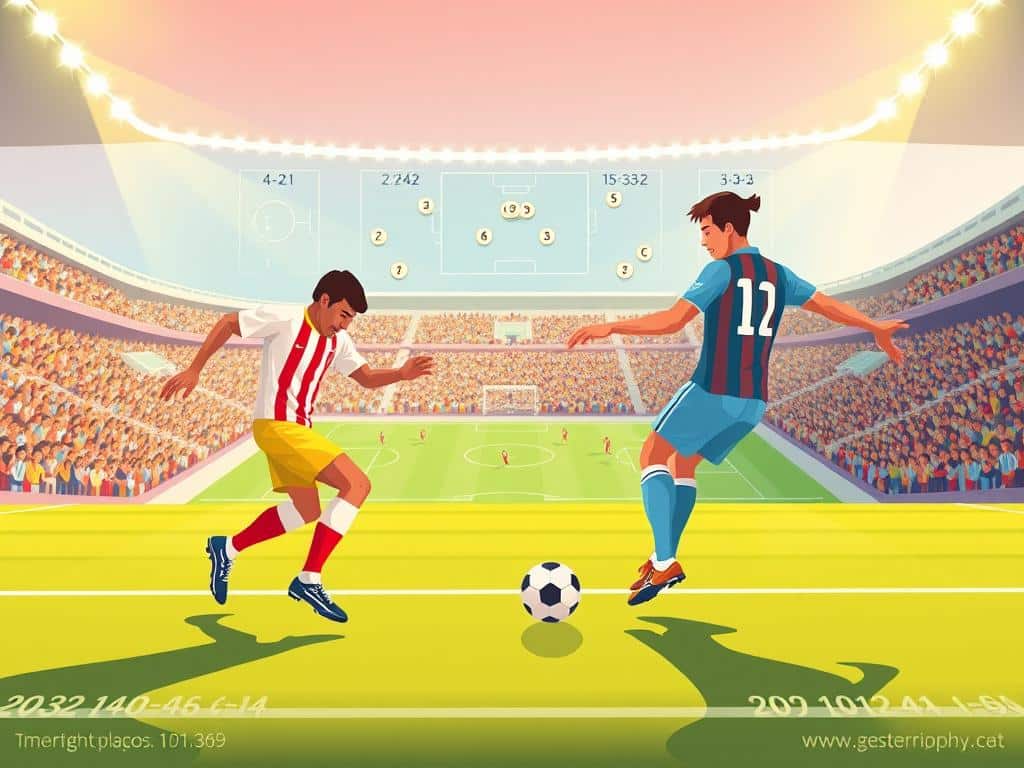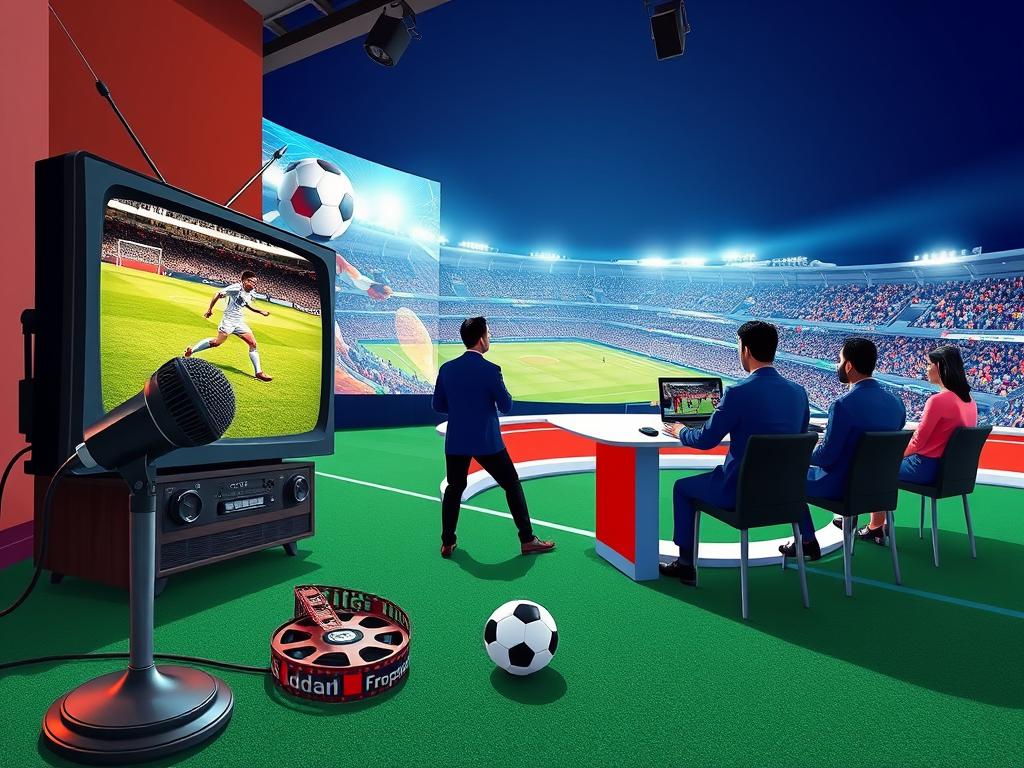Did you know that German football has won four World Cup titles? That’s more than any other European nation! From historic victories to legendary players, this squad’s journey is packed with unforgettable moments.
Over 120 years, the program transformed through political shifts, tactical innovations, and world-class talent. Icons like Beckenbauer and Klose didn’t just play—they redefined the game.
Whether you’re a casual fan or a die-hard follower, this guide breaks down how dedication and strategy built one of soccer’s greatest dynasties. Ready to dive in?
Introduction: The Legacy of German Football
Four World Cup trophies tell only part of the story. This football giant’s success blends raw talent, relentless discipline, and a system that breeds winners. With titles spanning six decades, their legacy is etched in history.
A Brief Overview of Germany’s Football Dominance
No European nation has lifted the FIFA World Cup more times. Their four victories—from the underdog triumph in 1954 to the 2014 masterclass—show adaptability across eras. Add three European Championships, and you’ve got a dynasty.
What’s their secret? Start with 27,000 youth clubs nurturing 1.8 million young players. Bundesliga academies polish raw gems into stars, ensuring the national team never lacks talent.
Why the Germany National Team Stands Out
Other teams peak and fade. This squad rebuilds without crumbling. Even after WWII split them into three teams, they reunited stronger. The 1974 clash with Holland’s “Total Football” proved their tactical grit.
Today, their blend of precision and passion inspires fans worldwide. Whether it’s a last-minute goal or a youth scout’s keen eye, every detail matters. That’s how legends are made.
Foundations and Early History (1900-1945)
Long before their World Cup triumphs, German football took its first steps on the international stage. The German football association (DFB) was born in 1900, laying the groundwork for a century of excellence. Let’s rewind to their 1908 debut—a fiery 3-5 loss to Switzerland that hinted at the battles ahead.
The Birth of the DFB and First International Matches
By 1912, the squad stunned the world at the Olympics. Gottfried Fuchs etched his name in history with a 10-goal rampage against Russia—a record that still dazzles fans today. Yet financial struggles kept them from the 1930 World Cup, a missed chance to shine.
Pre-WWII Challenges and Early World Cup Appearances
The 1934 World Cup introduced the “Breslau Elf,” a squad that crushed European rivals with ruthless efficiency. But four years later, politics overshadowed sport. The 1938 tournament saw a fractured “unified” team, weakened by Nazi interference.
From gritty beginnings to political turmoil, these early decades forged a resilience that would later define German football. The stage was set for a legacy of comebacks.
Post-WWII Split: West Germany, East Germany, and Saarland
Political turmoil in the 1940s led to a footballing divide between East, West, and even tiny Saarland. For over four decades, these teams carved separate legacies, each with its own triumphs and challenges.
The Impact of Political Division on Football
After WWII, Germany’s national team was banned until 1950. When FIFA lifted restrictions, the country was already split. East Germany formed its own squad, while Saarland—a tiny region—briefly fielded an independent team.
Saarland’s seven-year football independence (1947–1956) is a quirky footnote. They even tried qualifying for the 1950 World Cup, though FIFA rejected their application. Meanwhile, east german football thrived under Soviet influence, winning Olympic gold in 1976.
West Germany’s Rise to Prominence
West Germany’s comeback was swift. By 1954, they stunned the world with their first World Cup win (more on that in Section 5). Their secret? A focus on youth development and tactical discipline.
The 1974 World Cup added drama when East and West clashed in a group-stage match. East Germany’s 1-0 victory was symbolic, but West Germany lifted the trophy—proving resilience trumped politics.
Reunification in 1990 merged two football philosophies. The result? A third World Cup title just months later. Talk about a storybook ending.
The Miracle of Bern: 1954 World Cup Victory
Hungary’s unbeaten streak seemed untouchable—until one unforgettable match changed everything. The 1954 World Cup final wasn’t just about soccer; it became a symbol of hope for a nation rebuilding after war. Underdog West Germany’s 3-2 victory, dubbed the “Miracle of Bern,” remains one of sport’s greatest upsets.
The Historic Upset Against Hungary
Hungary’s “Mighty Magyars” hadn’t lost in 32 games, crushing opponents with fluid, attacking play. Yet coach Sepp Herberger’s risky lineup—resting stars in an earlier 8-3 loss to Hungary—paid off. When the teams met again in the rain-soaked final, Fritz Walter’s leadership and tactical adjustments turned the tide.
With mud slowing Hungary’s precision, West Germany clawed back from 2-0 down. The scored winning goal came in the 84th minute, a rocket from Helmut Rahn that sealed their underdog triumph.
Helmut Rahn’s Winning Goal and Its Significance
Rahn’s strike wasn’t just a goal—it ignited national pride. Post-WWII Germany, still divided and demoralized, found unity in this victory. The 1954 World Cup win proved resilience could overcome even the mightiest foes.
Today, the match is a masterclass in belief. From Herberger’s gambles to Rahn’s iconic moment, every detail showcases how the scored winning goal rewrote history. For fans, it’s a timeless reminder: miracles happen on the pitch.
Golden Eras: 1970s and 1980s
Few eras in football history shine as brightly as the 1970s and 1980s. This was a time of tactical revolutions, legendary players, and unforgettable matches. If you love drama and dominance, buckle up.
1974 World Cup: Triumph on Home Soil
The 1974 World Cup wasn’t just a tournament—it was a showdown. Host nation West Germany faced Holland’s “Total Football” in the final. Johan Cruyff’s flair met Franz Beckenbauer’s steel. Guess who won?
Gerd Müller’s 68th-minute strike sealed the 2-1 victory. The world cup final became a masterclass in adapting to opponents. Rain soaked the pitch, but the fans? Pure electricity.
Euro 1972 and 1980: Continental Dominance
Two European Championships, two trophies. In 1972, Beckenbauer led a squad that crushed the USSR 3-0. Eight years later, Horst Hrubesch’s header clinched the title against Belgium. Talk about clutch.
But not all was glory. The 1982 “Disgrace of Gijón” saw West Germany and Austria accused of match-fixing. FIFA responded with simultaneous final group games—a rule still used today.
Franz Beckenbauer’s Leadership as Player and Coach
Franz Beckenbauer didn’t just play; he revolutionized the sweeper role. With 103 caps, his vision defined an era. Later, as coach, he guided the squad to the 1986 and 1990 finals. Few have dominated both sides of the touchline like Der Kaiser.
His legacy? A blend of elegance and grit. Whether intercepting passes or inspiring teammates, Beckenbauer was the heartbeat of a golden age.
1990 World Cup: Unification and Glory
History was made in 1990 when football and politics collided in an unforgettable moment. The 1990 World Cup wasn’t just a tournament—it symbolized a nation healing. As the Berlin Wall fell, players from East and West united under one flag, chasing destiny.
The Fall of the Berlin Wall and Its Impact
Months before the world cup final, Germany reunified. For the squad, this meant:
- New talent pools from former East German clubs.
- Emotional locker-room moments as divided players became teammates.
- A surge of national pride fueling their campaign.
Coach Franz Beckenbauer masterfully blended styles, proving unity bred strength.
Andreas Brehme’s Penalty and the Third Title
The final against Argentina was tense. Diego Maradona, guarded by Berti Vogts, barely breathed. Then, in the 85th minute—Andreas Brehme stepped up. His icy-nerved penalty sealed the 1-0 win, delivering Germany’s third title.
Lothar Matthäus, earning his 150th cap, lifted the trophy. This victory wasn’t just about football. It was a story of a nation—and a team—rising together.
Legendary Players Who Shaped German Football
Legends aren’t born—they’re forged on the pitch through moments that redefine the game. These players didn’t just score; they inspired generations with skill, resilience, and sheer brilliance. Let’s celebrate the icons who turned matches into masterpieces.
Gerd Müller: The Bomber
Marvel at Gerd Müller’s 68 goals in just 62 caps—a 0.97 goal-per-game ratio that’s still unmatched. Nicknamed “Der Bomber,” his lethal finishes powered West Germany’s 1974 World Cup win. Whether a tap-in or a volley, Müller’s precision made him the ultimate poacher.
Lothar Matthäus: The Record Holder
No player has matched Matthäus’ 150 caps or five World Cup appearances. The midfield engine combined tireless stamina with pinpoint passes, captaining the 1990 squad to glory. His duel with Maradona in the final? Pure football poetry.
Miroslav Klose: World Cup’s Top Scorer
From Polish leagues to World Cup history, Klose’s 16-tournament goals broke Ronaldo’s record. His iconic somersaults celebrated 71 strikes for Germany—proof that longevity and instinct trump flashy tricks. The ultimate big-game player.
Compare eras: Beckenbauer’s elegance, Ballack’s power, and Neuer’s sweeper-keeper revolution. Each redefined their position, proving greatness wears many boots. Who’s your favorite?
The Lost Years: Struggles and Rebuilding (1998-2006)
Not every chapter in this story is about glory—some are about grit and comebacks. After decades of dominance, the early 2000s tested the squad’s resilience. From humiliating exits to unexpected finals, this era reshaped their future.
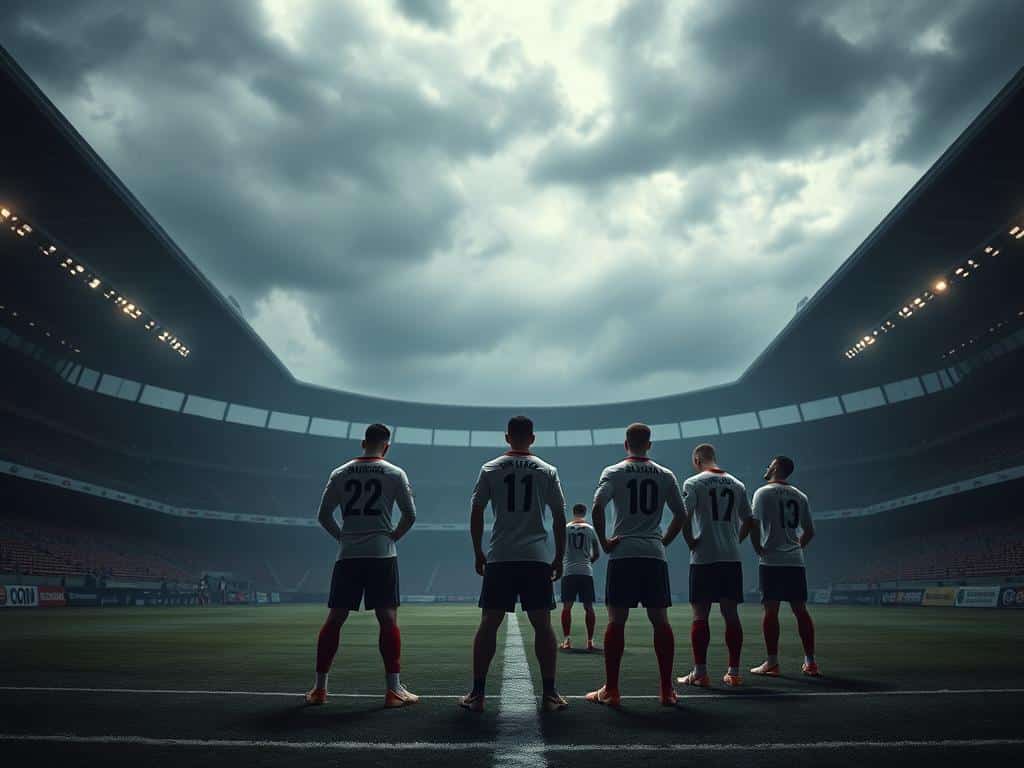
Euro 2000 and 2004: Group Stage Exits
The euro 2000 campaign was a disaster. With just one point in the first round, the team suffered a 3-0 thrashing by Portugal. Fans questioned everything—from tactics to player commitment.
Four years later, history repeated. Another first round exit at Euro 2004 signaled a crisis. Coach Rudi Völler faced criticism, but injuries and aging stars limited his options. The golden era felt like a distant memory.
The 2002 World Cup: A Surprise Run to the Final
Amid the chaos, one bright spot emerged. The 2002 World Cup saw an underdog squad defy odds. Without suspended star Michael Ballack, Oliver Kahn’s heroics in goal earned him the Golden Ball. His saves carried them past the USA and South Korea.
The final against Brazil? A bridge too far. Ronaldo’s brace sealed a 2-0 loss, but the team’s grit won hearts. For fans, it was proof that even in “lost years,” pride never faded.
By 2006, hosting the World Cup reignited hope. The “Summer Fairy Tale” wasn’t just a tournament—it was a rebirth. From rock bottom to redemption, this era laid the groundwork for future triumphs.
The Löw Era: Modernizing German Football (2006-2021)
When Joachim Löw took charge in 2006, he didn’t just coach—he reinvented how football was played. His 15-year tenure blended tactical genius with bold experimentation, turning a struggling squad into world champions. This era redefined expectations, from the infamous 7-1 Brazil thrashing to a sweeper-keeper revolution.
Joachim Löw’s Tactical Revolution
Gone were the rigid 4-4-2 formations of the past. Löw’s fluid 4-2-3-1 system prioritized:
- Pressing high to force turnovers in dangerous areas
- Fullbacks acting as wingers to overload defenses
- Manuel Neuer’s 5.5km sweeper-keeper sprints (vs Algeria in 2014)
This approach crushed opponents with speed. The 2014 World Cup proved its peak—27 shots and 14 on target in the semi-final alone.
2014 World Cup: Redemption in Brazil
After near-misses in 2008 and 2010, Löw’s squad dominated the 2014 world stage. Mats Hummels’ header silenced France in the quarters. Then came the Mineirazo—the 7-1 semi-final where Germany scored 4 goals in 6 minutes against Brazil.
Key stats from that historic match:
- 70% possession
- 100% tackle success rate
- 5 different scorers
The 7-1 Thrashing of Brazil and Its Aftermath
That scoreline wasn’t just a win—it shattered records. Toni Kroos’ quickfire double (24’ and 26’) left fans speechless. By halftime, it was 5-0, with social media calling it “football’s version of a mic drop.”
The final against Argentina tested nerves. When Mario Götze volleyed home in the 113th minute, Germany reclaimed the trophy after 24 years. For Löw, it validated his boldest ideas. For fans? Pure euphoria.
Germany National Soccer Team Evolution: Tactical Innovations
Tactics win matches, but systems build dynasties—here’s how German football reinvented itself. Over decades, shifts in style transformed them from defensive stalwarts to attacking maestros. Let’s break down the blueprint behind their success.
From Defensive Solidity to Attacking Fluidity
Post-2000, a seismic shift occurred. Coaches swapped rigid backlines for high pressing and positional play. Freiburg’s academy even made players study tactics on team buses—homework that paid off.
Compare Sepp Herberger’s “11 friends” mantra to Joachim Löw’s geometric passing. The result? A style blending Bundesliga precision with international flair. By 2014, their 7-1 thrashing of Brazil showcased this evolution.
The Influence of Bundesliga Academies
Behind every star lies a youth system. With 27,000 clubs and 1,200 UEFA Pro License coaches, the pipeline never dries up. Take the 2000s reforms:
- League academies like Stuttgart’s birthed Kroos and Khedira
- RB Leipzig’s counter-pressing model, inspired by Rangnick
- 34-hour school weeks balancing books and boots
Today, the league’s focus on technical creativity ensures the clubs keep feeding the national squad. From grassroots to glory—that’s the German way.
Major Tournament Records and Statistics
Numbers tell stories—here’s how Germany’s tournament dominance stacks up. With 20 FIFA World Cup appearances and 8 finals, their legacy is built on consistency and clutch performances. Let’s break down the highs, lows, and record-shattering moments.
World Cup Performances: A Historical Overview
The 1954 “Miracle of Bern” wasn’t just an upset—it set a scoring standard. That squad averaged 6.12 goals per game, a far cry from 2014’s possession-focused 2.3. Yet both strategies delivered trophies.
Fast-forward to 2018: a shocking group stage exit stunned fans. But even legends stumble. Miroslav Klose’s rise to top World Cup scorer (16 goals across 4 tournaments) remains a bright spot.
European Championship Highlights
Three UEFA European Championship titles speak to continental mastery. The 1996 golden goal final against the Czech Republic is iconic—Oliver Bierhoff’s winner cemented their “tournament team” reputation.
From 1972’s 3-0 demolition of the USSR to 2008’s runner-up finish, these campaigns prove adaptability. Whether grinding out wins or dominating possession, the stats never lie.
Cultural Impact and Global Influence
From tactics to fan culture, German football’s influence stretches far beyond the pitch. The german football association (DFB) didn’t just build a team—it reshaped how the sport is played worldwide. Whether it’s youth academies or iconic stadium atmospheres, their mark is undeniable.
How German Football Shaped the Sport Worldwide
High pressing, sweeper-keepers, and positional play—these aren’t just tactics; they’re German exports. After the 2014 fifa world cup, teams from Spain to the U.S. adopted their aggressive style. Even Jurgen Klinsmann’s USMNT reforms mirrored DFB methods.
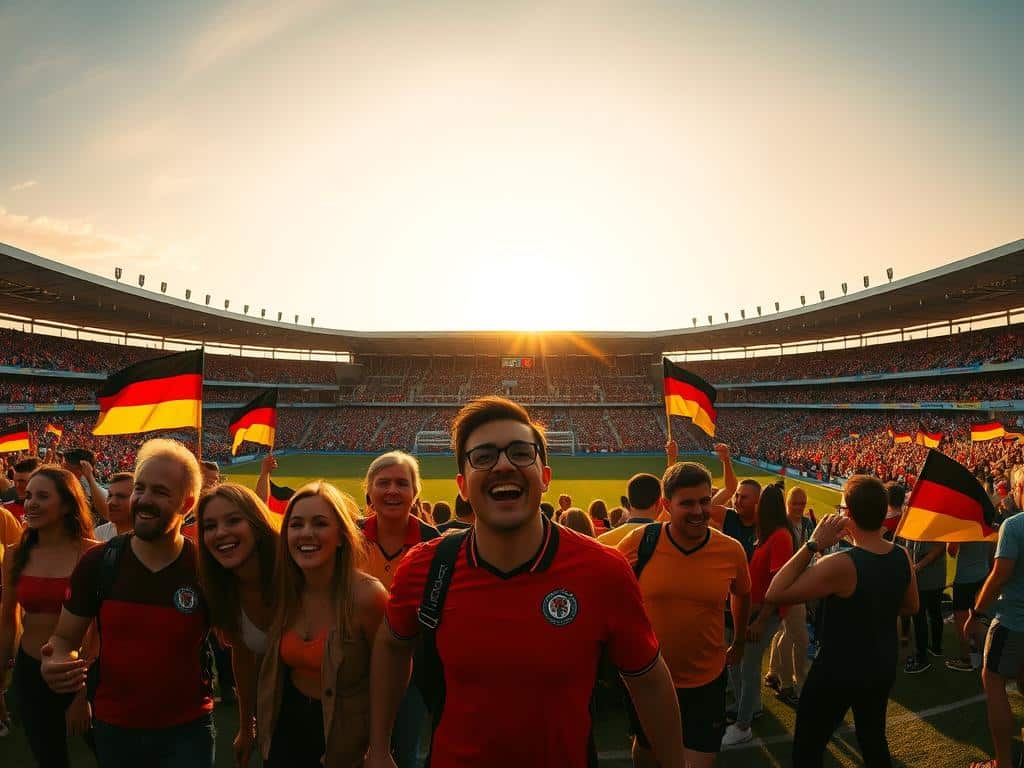
Consider the numbers: 1,200+ Bundesliga players now compete abroad, spreading their philosophy. Freiburg’s academy, balancing school and soccer, became a global model. The nation’s focus on technical creativity set new standards.
The DFB’s Role in Youth Development
With 121 training centers and 1,000+ Pro License coaches, the german football association invests heavily in the future. Their “school first” policy ensures young talents like Jamal Musiala excel academically and athletically.
Key innovations include:
- Coaching diplomas recognized worldwide for rigor and depth.
- Dortmund’s “Yellow Wall” inspiring fan-centric stadium designs.
- RB Leipzig’s data-driven scouting, now emulated across Europe.
This nation’s legacy isn’t just trophies—it’s a roadmap for sustainable success. From grassroots to glory, the DFB proves football is more than a game.
The Future of German Football
Change is coming fast for this storied squad. After a shocking 2022 World Cup group exit, fresh faces like Jamal Musiala and Florian Wirtz are leading the charge. Their flair and fearlessness hint at brighter days ahead.
Coach Hansi Flick’s high-pressing style, honed at Bayern Munich, could redefine the team’s identity. With the 2024 Euros on home soil, redemption feels within reach. Imagine the roar if these young players lift the trophy!
Challenges remain. The Bundesliga’s 50+1 rule keeps talent local but limits spending power. Meanwhile, climate protests during matches show football’s role in bigger debates. One thing’s clear: this time of transition will shape the next era.
For fans, the excitement lies in watching a new generation write its own story. Will they honor the past while forging something bold? The pitch awaits their answer.

